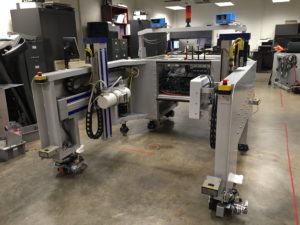MABE professors Richard Komistek and Bill Hamel and their graduate students are using a robotic fluoroscope to obtain new insight into the design and post-operative results of artificial joint replacements, a growing and important area of health care.
Stationary fluoroscopy has been used for years to study the in vivo kinematics (3D motion) and kinetics (joint forces) of people with knee and hip joint replacements. These studies provide data that are used by orthopedic surgeons and implant manufacturers to evaluate and improve their designs and post-operative performance.
The robotic fluoroscope is a major advancement over stationary fluoroscopy that allows such studies to be performed as subjects perform maneuvers with the full and natural engagement of their entire musculoskeletal system. This provides the best possible information regarding how effective the subject’s joint replacement really functions.
The robotic fluoroscope is an advanced mobile robot with extensive use of embedded digital computers, an x-ray imaging system, and special sensors. It has two control systems; one that allows the robot to follow the person’s body motion as they walk; and one that tracks the joint being studied, either a hip, a knee, or an ankle as it moves relative to the torso. The robotic fluoroscope has 4 degrees of freedom associated with tracking the relative motion of the person’s joint of interest, and 8 degrees of freedom in its drive wheels that allow the overall system to follow them as they walk in straight or curved paths. Body tracking is accomplished by using laser range scanners to profile the location and direction of the upper body torso. Computer vision is used to identify and track the location of the joint of interest.
The group has used the robotic fluoroscope in clinical studies of over 200 knee replacement patients.
The video below shows the robotic fluoroscope being used.

